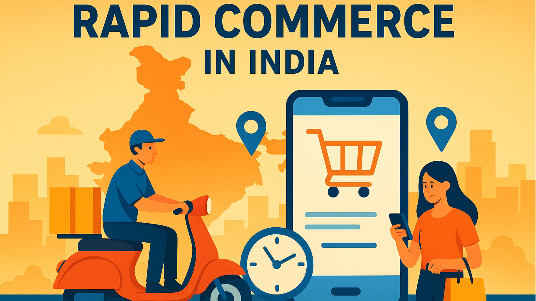Currently worth only a few hundred million dollars, the market’s growth trajectory is described as “explosive”, with triple- and quadruple-digit growth possible in the next few years.

Rapid Commerce
India’s rapid commerce market, defined as deliveries within 2 to 6 hours is poised to cross $20 billion by 2030, as per a recently unveiled white paper on rapid commerce developed by DTDC Express Ltd in collaboration with Boston Consulting Group (BCG). This growth is driven by shifting consumer expectations, rising disposable incomes, and logistics innovation. Unlike hyper-fast 10–15-minute deliveries offered by quick commerce platforms, rapid commerce represents a scalable middle ground between speed and cost efficiency, with massive potential beyond metros.
“Three forces are converging,” says Rahul Sanghvi, MD & Partner, BCG Consulting. “First, rising spending among the middle class, including in Tier 2 and 3 cities. Second, greater digital penetration—with online shoppers jumping from 5 lakh in 2010 to 25 crore today, projected to hit 50 crore by 2030. Third, a reset in customer expectations—speed and convenience are now non-negotiable.”
Abhishek Chakraborty, Chief Executive Officer - DTDC Express Limited adds, “India’s demographic dividend is central. Young, digital-first consumers are prioritizing convenience over cost, willing to pay a premium for faster delivery. That shift will power the segment.”
Currently worth only a few hundred million dollars, the market’s growth trajectory is described as “explosive”, with triple- and quadruple-digit growth possible in the next few years.
Rapid commerce occupies the space between traditional marketplaces (2–4 day delivery) and quick commerce (10–15 minutes). “Not every product needs 10-minute delivery, nor do customers want to wait 3–4 days,” explains Chakraborty. “The sweet spot is 2 hours, 4 hours, even same-day delivery.”
That model is now being adopted across sectors from BigBasket in grocery, Myntra and Flipkart in fashion, to individual D2C brands expanding offline. Players including Healthkart (supplements, beauty) is already leveraging rapid delivery for higher customer stickiness.
While e-commerce giants including Amazon and Flipkart can build proprietary networks, most D2C brands cannot. They’re turning to third-party logistics players offering shared dark stores and pay-as-you-go models.
“Our infrastructure covers 70% of India, reaching 96% of the population with over 15,500 partners and 600 facilities,” says Chakraborty of DTDC. “This scale allows us to enable rapid commerce without brands needing to invest in their own networks.”
This model also eliminates the burden of dark store investments for smaller players, instead offering “dark store as a service”—flexible, scalable, and cost-effective.
The boom is not confined to metros. In cities including Kochi and Nashik, rapid commerce is enabling intra-city deliveries within hours, and even next-day access to Tier-III towns—something unimaginable just a few years ago.
“In metros, rapid commerce is the natural extension of quick delivery expectations,” notes Chakraborty. “But in Tier 2 and 3, it solves access gaps. Consumers want premium products they can’t find offline, and they’re adopting this model faster than expected.”
Categories seeing the sharpest traction include grocery, electronics, cosmetics, FMCG, and even auto spares. A startup DTDC works with is digitizing spare parts supply for mechanics—cutting sourcing time from hours to minutes and boosting productivity.
Industry estimates peg a $2 billion-plus logistics opportunity in dark stores and last-mile delivery. To capture it, logistics players are blending infrastructure with tech innovation.
DTDC, for instance, is building “dream stores”, dark stores optimized for storage and distribution, strategically located near demand hubs. On the tech side, AI and predictive analytics are being deployed for:
a) Smart batching: Grouping orders by product similarity and geography.
b) Dynamic routing: Real-time adjustments for traffic and weather.
c) GeoZone system: Enabling accurate deliveries in smaller towns with vague addresses.
d) Predictive inventory slotting: Placing fast-moving items closer to dispatch points.
“Most of the heavy lifting is being done by tech,” says Chakraborty. “Intelligent micro-decisions make rapid commerce both fast and cost-efficient.”
Alongside consumer convenience, rapid commerce is expected to create significant employment opportunities in both urban and rural areas. Agile, flexible delivery networks will scale quickly to handle peak demand, while shared models reduce costs for brands.
India’s e-commerce market, currently at $125 billion, is projected to reach $300 billion within two years. Even if rapid commerce captures just 10% of that, the segment will be worth $10–12 billion in the near term, scaling to $20–40 billion in the next decade.
As Sanghvi sums up: “Quick commerce will remain urban-heavy. But rapid commerce—affordable, scalable, and pan-India—will define the next big chapter of Indian retail.”
Empower your business. Get practical tips, market insights, and growth strategies delivered to your inbox
By continuing you agree to our Privacy Policy & Terms & Conditions
